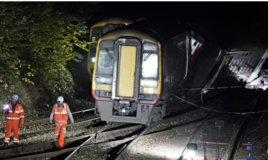Slippery rails, resulting from autumn leaves on the line, has been identified as a cause of the collision between two trains near Salisbury last October in which 14 people were injured.
An interim report by investigators from the Rail Accident Investigation Branch found extensive evidence of crushed leaf mulch on the railhead at many sites on the approach to Salisbury Tunnel Junction.
A South Western Railway service passed a red signal and collided with a Great Western Railway service in front of the eastern tunnel portal, as both trains moved onto the same track in the same direction (RAIL 944, 945).
The impact caused both trains to derail and enter the tunnel together before coming to a standstill. There was extensive damage to both trains and the track.
There had been strong winds and heavy rain in the area on the day of the crash, and other services across the region had been disrupted by numerous trees blocking the tracks.
RAIB investigators found evidence of railhead contamination by crushed leaves at 12 locations in the two miles leading up to the crash.
They reported: “Many areas had a medium or heavy level of contamination… deposits were smeared and flaky, and typical of the sort of contamination layers which exist after train wheels have slid over them.”
A railhead treatment train had been due on the route only an hour and a half before the crash, but it had been rescheduled for later that evening. The most recent treatment train had last run over the line 32 hours previously, using a high-pressure water jet. It was not required to apply adhesion gel at this location. The gel is intended to break up any remaining leaf film on the railhead, to increase adhesion.
Before publishing a final report and making recommendations, RAIB will further consider the actions of the driver, and the policies of both Network Rail and South Western Railway relating to the operation of trains in conditions of low adhesion.
To read the full story, see RAIL 952.















Login to comment
Comments
No comments have been made yet.